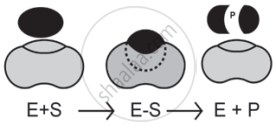Advertisements
Advertisements
प्रश्न
Long answer question.
Describe the models for enzyme actions.
थोडक्यात उत्तर
उत्तर
There are two types of models:
- Lock and Key model:
- The lock and Key model was first postulated in 1894 by Emil Fischer.
- This model explains the specific action of an enzyme with a single substrate.
- In this model, the lock is the enzyme and the key is the substrate.
- The correctly sized key (substrate) fits into the key hole (active site) of the lock (enzyme).

Lock and key model
- Induced Fit model (Flexible Model):
- Induced Fit model was first proposed in 1959 by Koshland.
- This model states that the approach of a substrate induces a conformational change in the enzyme.
- It is the more accepted model to understand the mode of action of an enzyme.
- The induced-fit model shows that enzymes are rather flexible structures in which the active site continually reshapes by its interactions with the substrate until the time the substrate is completely bound to it.
- It is also the point at which the final form and shape of the enzyme are determined.

Complex Flexible model
shaalaa.com
Biomolecules in the Cell
या प्रश्नात किंवा उत्तरात काही त्रुटी आहे का?
APPEARS IN
संबंधित प्रश्न
Explain the peptide bond.
Answer the following question.
Enlist the examples of simple protein and add their significance.
Answer the following question.
Explain the secondary structure of a protein with examples.
Complete the following chart.
| Protein | Physiological role |
| Collagen | ___________ |
| __________ | Responsible for muscle contraction |
| Immunoglobulin IgG | ___________ |
| ___________ | Significant in respiration |
| Fibrinogen | ____________ |
Long answer question.
Explain the classes of carbohydrates with examples.
Long answer question.
What are enzymes?
Long answer question.
How metabolic pool is formed in the cell.
Name the term that describes all the chemical reactions taking place in an organism.
Name the form in which carbohydrate is transported in a plant.
The most abundant molecule in cell is ______.
